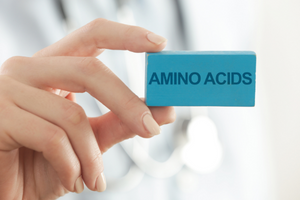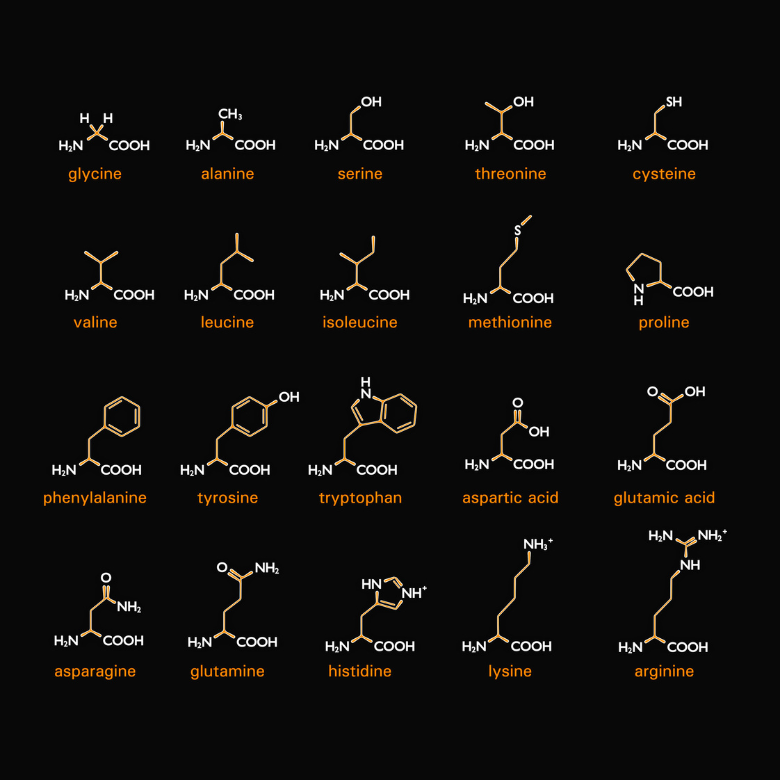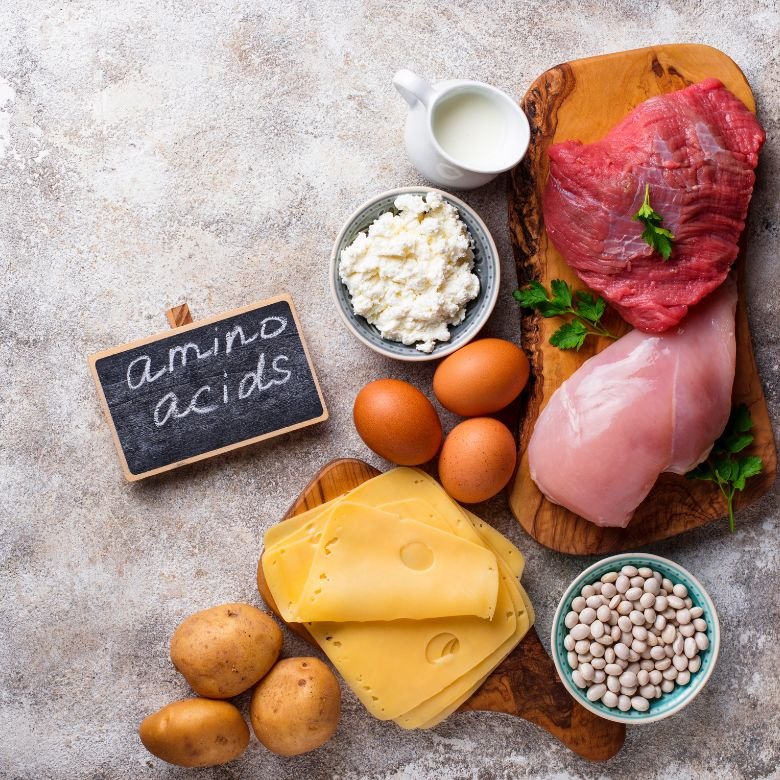Amino acids are a group of organic compounds whose structure consists of the atoms of carbon, nitrogen, hydrogen and oxygen as well as a variable lateral chain group. They are bifunctional compounds whose molecules include COOH carboxyl groups and NH2 amine groups.

The general formula of amino acids is as follows:
NH2 – R – COOH
Their name is an abbreviated form of the term “α-amino carboxylic acid”. When we talk about different types of amino acids, we often substitute their systematic names with customary names. To give an example, the aminoacetic acid is called glycine, the 2-aminopropanoic acid is called alanine, and the 2-amino-3-methylbutanoic acid is called valine.
Classification of amino acids
The main division of amino acids is into protein and non-protein types. The former group includes around 20 compounds, each of which is a component of proteins and is crucial for the human body. These proteins, which also exist as structural molecules in plants and animals, play a fundamental role by taking part in many mechanisms responsible for maintaining the homeostasis in human bodies. Another classification takes into account the possibility to produce a particular amino acid or its required supply to the human body together with food.
Exogenous and endogenous amino acids
Exogenous amino acids are organic compounds required to maintain the homeostasis in our bodies, yet they are not capable of self-production. This is why they must be supplied in the form of an appropriate diet along with properly balanced meals and in the form of adequate supplements. This group of amino acids includes:
- Lysine – an anti-virus amino acid which improves immunity;
- Methionine, which controls the production of the growth hormone;
- Threonine, which is responsible for the proper maintenance of skin moisture and proper functioning of the nervous system;
- Leucine, whose main role is to control the level of secreted cortisol and sugar levels as well as to support wound healing;
- Isoleucine – an amino acid that takes part in muscle metabolism processes, with a particular focus on muscle tissues;
- Valine, which supports muscle recovery and the removal of excess fat tissue;
- Tryptophan, a serotonin precursor, which is to increase the quality of sleep, improve the physical and mental state, and control appetite;
- Phenylalanine, being a precursor of many hormones important to the human body, including tyrosine, dopamine, epinephrine and noradrenaline.
The other category includes endogenous amino acids, which are regularly synthesized in human body, so the demand for them is constantly covered on an autonomous basis. This group contains more amino acids, which include:
- Alanine – an amino acid responsible for carrying glucose to red blood cells and the brain;
- Aspartic acid, which improves cognitive functions and the ability to concentrate;
- Asparagine, which supports many processes such as learning, memorising, or concentration improvement;
- Glutamic acid, which supports digestion processes, reduces the feeling of fatigue, and supports memory.
Conditional amino acids
These are compounds which can be produced in the body but only in case of access to appropriate amounts of their precursors. Conditional amino acids include:
- Arginine, which delays ageing, reduces the time of healing wounds, and improves physical fitness;
- Cysteine, which is a building material in the forming of glutathione and is an important production element of collagen;
- Glutamine, which supports the functioning of the intestines and the removal of unnecessary metabolic products from the human body;
- Tyrosine, which, just like cysteine, takes part in the production of collagen, but is also necessary for the synthesis of melanin and helps maintain the homeostasis of the thyroid gland;
- Glycine, which is an amino acid capable of healing arthritis and diabetes;
- Ornithine, which is capable to reduce the level of cortisol, improve the quality of sleep, and enhance the efficiency intestine functions and digestive enzymes;
- Proline, which favourably affects the condition of the skin and improves its flexibility;
- Serine, oriented to processes that support the immune system and the functioning of neurons.
Protein amino acids
As the name suggests, there are also amino acids being components of proteins. More specifically, proteins are various types of amino acids combined with one another. There are twenty of them, and during synthesis they are coded by so-called codons (sequences of three nucleotides contained in the mRNa, which constitute the coding unit). Each of them has two common features: they are alpha- and L-amino acids. This means that their amine group is connected to the alpha-carbon, which directly adjoins the carbonyl group. The letter “L” stands for a stereoisomer in the Fischer projection, so the amine group is located on the left side of the formula.

The physico-chemical properties of amino acids
The physical form of amino acids is usually a crystalline solid having a sweet taste. Their solubility in water is good, but they do not dissolve in organic solvents. Their melting points are relatively high. The chemical nature of amino acids is amphoteric, and the reaction of their aqueous solutions is neutral. Dissociation produces dual ions, which are the outcome of neutralising the basic amine group with a carboxyl radical . This results in producing an internal ammonium salt that shows both charges: positive and negative. Their quantities are equal. An amino acid can exist as a cation or anion, depending on the environment in which it dissociates. For acidic reactions, the carboxyl group does not dissociate and the amino acid has a positive charge. In an alkaline environment, the reactions shifts towards producing a negative ion.
The isoelectric point (pI)
It is a point where an amino acid takes the form of a dual ion. For each molecule, we can adjust an adequate concentration of [H3O+] ions, meaning such a pH where ions do not move in the electric field. The amphoteric nature of amino acids and their existence in the form of dual ions implies an ionic structure of salts when affected by acids and alkalis. Experimental determination of the isoelectric point is carried out by adding an amino acid, for example casein, into appropriate test tubes containing solutions (CH3COOH and CH3COONa) with known pH concentrations. The isoelectric point is reached where the deposit is most abundant. Given the characteristic of the isoelectric point, we can use it to separate a mixture of proteins with the use of electrophoresis. This method is based on the acidic-basic properties of amino acids, and the mixture is placed on wetted paper. With the use of a known pH, we can determine the form in which particular amino acids will exist. Then, if we supply voltage to the paper, the positively charged amino acids will move towards the cathode (-), and those with a negative charge, to the anode (+). The neutrally charged compounds, balanced by the positive and negative charges in the molecule, will remain in the same place.
Reactions characteristic of the carboxyl group
- Esterification, which consists in synthesizing esters produced by a reaction between an amino acid and an alcohol. The product of such a reaction does not show an amphoteric nature, but does show the properties of the amine used.
- Decarboxylation, that is the heating of an amino acid in the presence of a barium (II) hydroxide (Ba(OH)2) solution. The transformation produces amines.
- The production of complexes is related to the amino acids’ capability to bond with the cations of a metal, mainly copper, which causes the formation of coloured compounds (complex salts).

Reactions characteristic of the amine group
- Deamination, which concerns amino acids that contain the primary amine group. The reaction occurs under the influence of nitric (III) acid (HNO2), and the amino acid used as a reactant oxidises and produces a hydracid. The amine group is released in the form of nitrogen. There are several types of deamination, including hydrolytic deamination, hydrolytic deamination with decarboxylation, deamination by reduction, and desaturation deamination.
- Oxidation, which causes amino acids to convert into keto acids.
- Biochemical reactions – all amino acids that can be classified as Schiff bases are capable of biochemical transformations such as transmittance and decarboxylation.
Reactions used for detecting amino acids
- The ninhydrin reaction is a coloured reaction where the reactants are an amino acid and a reagent in the form of a ninhydrin solution. The reaction produces a characteristic violet-blue colour.
- The xanthoprotein reaction is an example of the path to detect aromatic amino acids, such as phenylalanine, tyrosine or tryptophan. A compound subjected to a concentrated nitric (V) acid (HNO3) solution changes its colour to yellow. It is a result of producing nitric amino acid derivatives during the reaction.
Sources of amino acids
To ensure a good physical and mental condition of the human body, we should provide it with appropriate amounts of each building material, including amino acids. An extremely important source of all amino acids required for proper functioning are the complete proteins. They include meat, in particular poultry, fish, eggs and dairy. Milk contains high amounts of leucine, isoleucine, threonine and tryptophan. Lysine and methionine can be found in soya. Valine can be supplied together with rice, peanuts, sesame and almonds, while phenylalanine, by including eggs, cheeses and cereal products in our diet. The presence of amino acids in food products is common, but for our diet to be properly balanced, the products we use should be diversified. This is because they contain only certain amino acids from the group necessary to maintain proper vital functions.